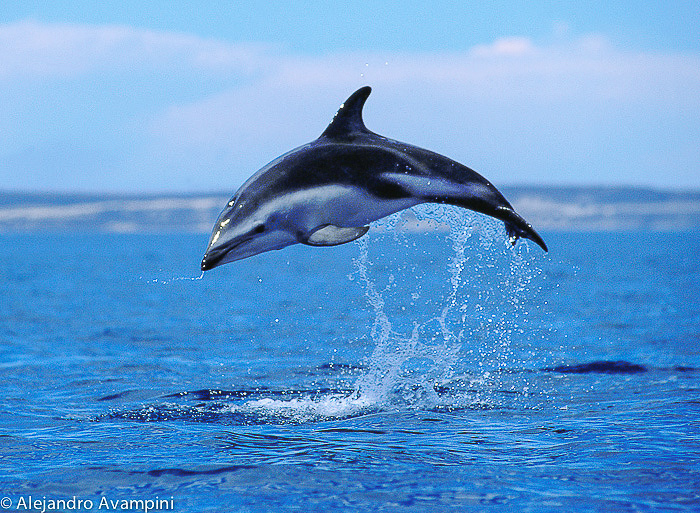 The wildlife that can be observed from Puerto Piramides is varied and numerous, each species with its own attractive attributes and season. This genetic reservoir, that has survived incalculable massacres resulting in the near extinction of many species, is on the rebound. Since the protection of this unique wildlife sanctuary began, each season that passes becomes even wilder. With each passing year the numbers do nothing but grow with respect to Whales, Sea Lions, Elephant Seals and other species.
The wildlife that can be observed from Puerto Piramides is varied and numerous, each species with its own attractive attributes and season. This genetic reservoir, that has survived incalculable massacres resulting in the near extinction of many species, is on the rebound. Since the protection of this unique wildlife sanctuary began, each season that passes becomes even wilder. With each passing year the numbers do nothing but grow with respect to Whales, Sea Lions, Elephant Seals and other species.  For this reason alone, the Valdes Peninsula invites you to visit over and over again. Its geography is a living natural laboratory. A painting in constant motion and a world built for Man to do nothing more than contemplate. A place that allows for the power of understanding and invigorating observation of the life cycle of the oceans giants, as well as dozens of other species, at any time of the year.
For this reason alone, the Valdes Peninsula invites you to visit over and over again. Its geography is a living natural laboratory. A painting in constant motion and a world built for Man to do nothing more than contemplate. A place that allows for the power of understanding and invigorating observation of the life cycle of the oceans giants, as well as dozens of other species, at any time of the year.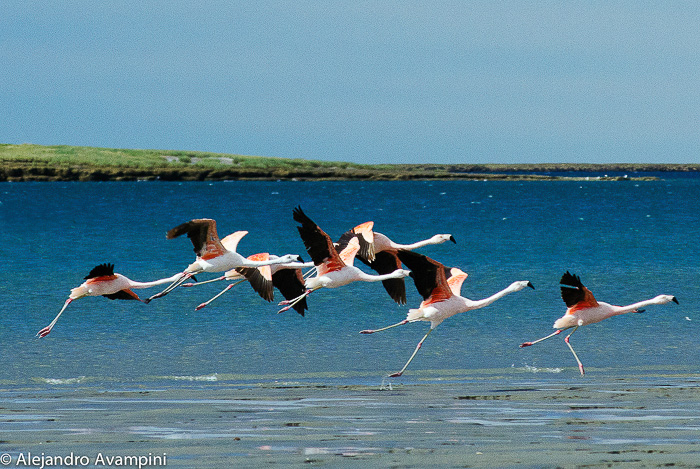 The annual migrations that many of these animals follow are truly admirable. Pushed on by instinct, at some calculated time each year, they will pass through the Valdes Peninsula. A perfect example, outside from the classic migrations of the Southern Right Whale or other marine giants, are two species of swallows that will travel between March and April, when cold weather begins to arrive, to Perú and Ecuador, returning once again to Patagonia in spring with longer days and warmer weather. These incredible peregrines of the natural kingdom, the Black Swallow and the Blue and White Swallow, are far from calling the attention of most tourists who arrive for whale watching tours. These small birds will migrate annually over tens of thousands of kilometers and, if for nothing else, deserve to be mentioned here.
The annual migrations that many of these animals follow are truly admirable. Pushed on by instinct, at some calculated time each year, they will pass through the Valdes Peninsula. A perfect example, outside from the classic migrations of the Southern Right Whale or other marine giants, are two species of swallows that will travel between March and April, when cold weather begins to arrive, to Perú and Ecuador, returning once again to Patagonia in spring with longer days and warmer weather. These incredible peregrines of the natural kingdom, the Black Swallow and the Blue and White Swallow, are far from calling the attention of most tourists who arrive for whale watching tours. These small birds will migrate annually over tens of thousands of kilometers and, if for nothing else, deserve to be mentioned here. Very different from the major attractions of Whale watching tours or Orca season in the Valdes Peninsula, are some of the land animals, mammals, rodents and others, each with their own particular beauty, that share the same neighborhood as the famous cetaceans. In this article you will see some wild animals and others not so wild, all sharing secondary roles to the maritime scheme, and always present for the patient visitor who takes his time while traveling the gravel roads of the Valdes Peninsula.
Very different from the major attractions of Whale watching tours or Orca season in the Valdes Peninsula, are some of the land animals, mammals, rodents and others, each with their own particular beauty, that share the same neighborhood as the famous cetaceans. In this article you will see some wild animals and others not so wild, all sharing secondary roles to the maritime scheme, and always present for the patient visitor who takes his time while traveling the gravel roads of the Valdes Peninsula.
Guanaco
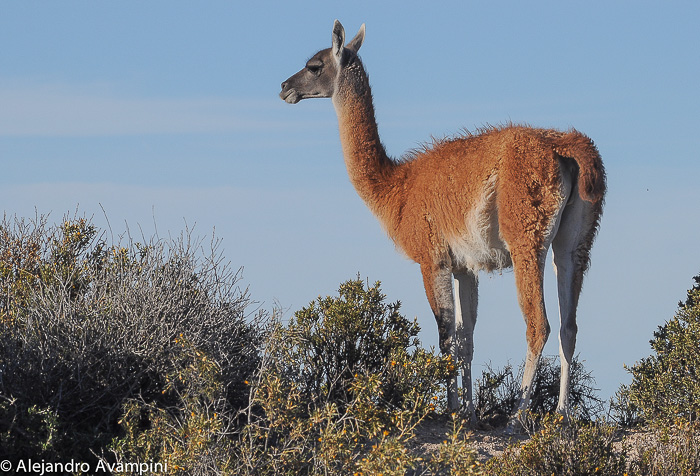 Guanacos (Lama guanicoe) , mammals related to Llamas and pertaining to the order of Camelidos, carry with humble dignity the title of being Patagonia’s largest land dwelling vertebrate. Before the arrival of Europeans, this beautiful species was a fundamental ally in the survival of Patagonia´s indigenous inhabitants, providing meat for food and hides for warmth. The Valdes Peninsula is a Provincial Nature Reserve but it is not entirely intangible. For this reason commercial activities are still carried out by the 56 Estancias (Ranches) that are primarily dedicated to sheep herding and wool production. This industry has its beginnings in the Valdes Peninsula at the beginning of 1900.
Guanacos (Lama guanicoe) , mammals related to Llamas and pertaining to the order of Camelidos, carry with humble dignity the title of being Patagonia’s largest land dwelling vertebrate. Before the arrival of Europeans, this beautiful species was a fundamental ally in the survival of Patagonia´s indigenous inhabitants, providing meat for food and hides for warmth. The Valdes Peninsula is a Provincial Nature Reserve but it is not entirely intangible. For this reason commercial activities are still carried out by the 56 Estancias (Ranches) that are primarily dedicated to sheep herding and wool production. This industry has its beginnings in the Valdes Peninsula at the beginning of 1900.
Sheep
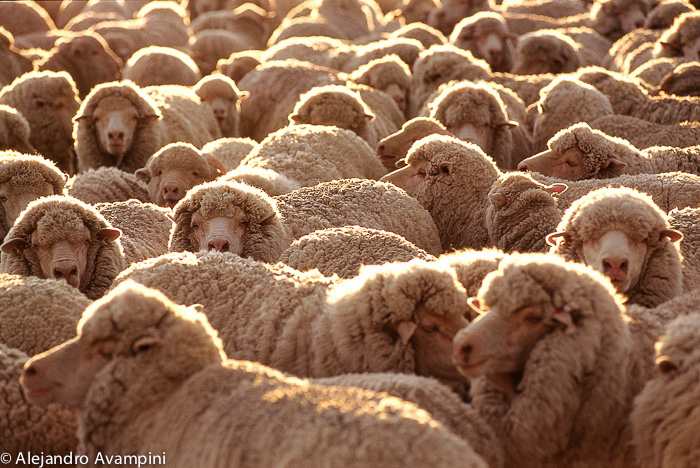 With colonization and non-indigenous development in the area, domestic animals arrived and one in particular dramatically changed the Patagonian Steppe. To raise and commercialize sheep and its subsequent byproducts certain inventions where applied in the region, like barbed wire fencing, private property and the division of land. Guanacos, displaced by the wool industry, were considerably reduced in numbers. Two fundamental characteristics of Guanacos are that they live together in large herds and are grazing herbivores. The Valdes Peninsula is a unique wildlife reserve where hunting is strictly prohibited and over the course of time, thanks to the application of this law, the number of Guanacos is now greatly superior in the peninsula when compared to the rest of Patagonia.
With colonization and non-indigenous development in the area, domestic animals arrived and one in particular dramatically changed the Patagonian Steppe. To raise and commercialize sheep and its subsequent byproducts certain inventions where applied in the region, like barbed wire fencing, private property and the division of land. Guanacos, displaced by the wool industry, were considerably reduced in numbers. Two fundamental characteristics of Guanacos are that they live together in large herds and are grazing herbivores. The Valdes Peninsula is a unique wildlife reserve where hunting is strictly prohibited and over the course of time, thanks to the application of this law, the number of Guanacos is now greatly superior in the peninsula when compared to the rest of Patagonia.
Patagonian Hare
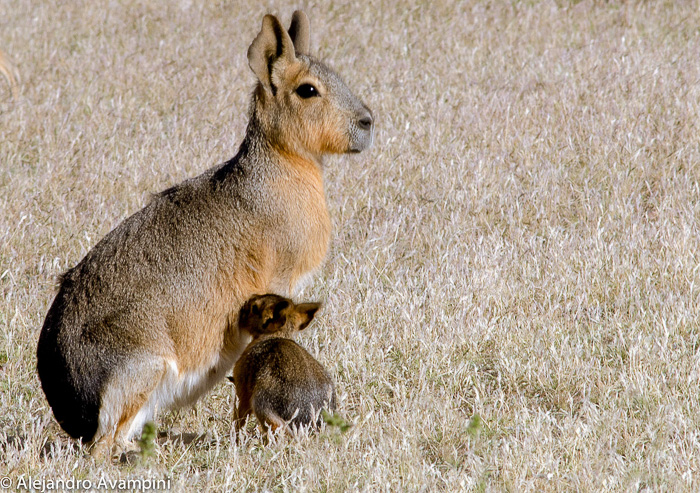
Often referred to as the Patagonian hare (Dolichotis patagonum), the Mara is a large rodent that exists only in Patagonia, can reach up to 70cm and is easily distinguished from the European Hare by the White marking near the tail and its small ears. They are monogamous and often several pairs will raise and protect their young together in the same burrow. Mating begins in June and July and with a 3 month gestation period the offspring can usually be seen in late September or October in Valdes Peninsula. Once pregnant the female will begin the construction of a tunnel of 1-2mt in length that ends in a large, irregular chamber. Once finished, she will no longer enter the chamber, reserved for her offspring who begin grazing 6 weeks after birth. A beautiful species, unique to Patagonia that will live close to 15 years. This irreplaceable World Heritage Site is home to many incredible animals because there is still enough space for them to thrive. Examples of other curious species that are willing to carry out their business in the presence of man are also present. Such is the case with the Patagonian Grey Fox, Patagonian Skunk and Dwarf Armadillo. Here I have attached a video that illustrates clearly the habits of the Patagonian Mara, a species emblematic to Patagonia.
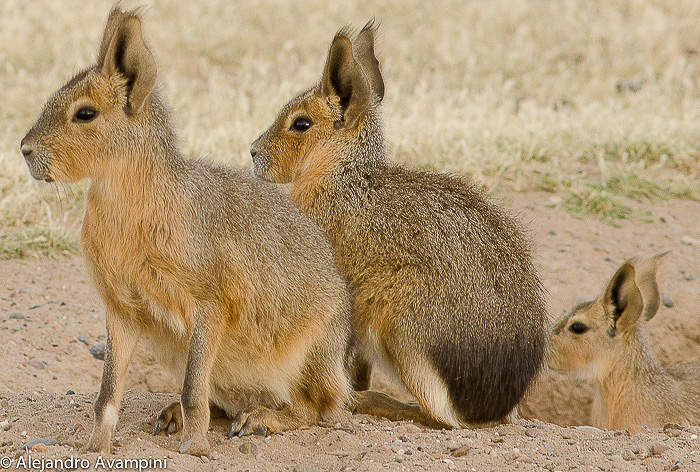
Patagonian Skunk
 There is an abundant population of Patagonian Skunks (Conepatus humboldtii) in the Valdes Peninsula and often they will be seen in areas of human activity. Such is the case in the area around Punta Delgada where they are easily observed. This species of skunk is not as social as others and is usually seen alone and will almost exclusively occupy its den alone. The female has a 42 day gestation period and will give birth to 2-5 offspring. The babies will nurse on the three pairs of teats the mother offers and after just three months of nursing, will feed on their own.
There is an abundant population of Patagonian Skunks (Conepatus humboldtii) in the Valdes Peninsula and often they will be seen in areas of human activity. Such is the case in the area around Punta Delgada where they are easily observed. This species of skunk is not as social as others and is usually seen alone and will almost exclusively occupy its den alone. The female has a 42 day gestation period and will give birth to 2-5 offspring. The babies will nurse on the three pairs of teats the mother offers and after just three months of nursing, will feed on their own.
Dwarf Armadillo
 The Dwarf Armadillo(Zaedyus pichiy), from the same family as the Mulita and Hairy Armadillo (Xenarthra), spends most of its time with its nose to the ground searching for food. It has short hair and seven articulated bands to its protective shell that are mostly grey with slightly curved, beige edges. It has much less hair on its shell than the Mulita or Hairy Armadillo and the bottom edge is serrated.
The Dwarf Armadillo(Zaedyus pichiy), from the same family as the Mulita and Hairy Armadillo (Xenarthra), spends most of its time with its nose to the ground searching for food. It has short hair and seven articulated bands to its protective shell that are mostly grey with slightly curved, beige edges. It has much less hair on its shell than the Mulita or Hairy Armadillo and the bottom edge is serrated.
Southern Dwarf Cavy
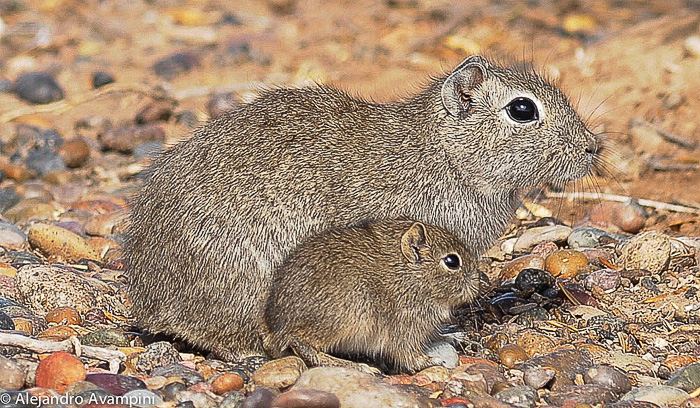 The Southern Dwarf Cavy or Brazilian Guinea Pig (Microcavia australis), is a mammal that feeds on sprouts of many plants and often climbs bushes and small trees to eat soft leaves. An enjoyable species to observe while the whales and Orcas remain below the surface. The female will go into heat for a period of approximately 5 hours, during which time she will be pursued and eventually mated by various males. The gestation period of these small animals is just under 2 months. Their behavior is often humorous to observe and, although not very sociable with humans, they can easily be seen while visiting the different tourist attractions in the area. A perfect example would be while sitting on the coast of el Doradillo waiting for a whale to breach, the Guinea Pig will most likely be close by in the bushes next to where you are sitting. If not for the subtle connections made by the observant visitor to this natural paradise, they would carry out their attractive lifestyle in complete anonymity.
The Southern Dwarf Cavy or Brazilian Guinea Pig (Microcavia australis), is a mammal that feeds on sprouts of many plants and often climbs bushes and small trees to eat soft leaves. An enjoyable species to observe while the whales and Orcas remain below the surface. The female will go into heat for a period of approximately 5 hours, during which time she will be pursued and eventually mated by various males. The gestation period of these small animals is just under 2 months. Their behavior is often humorous to observe and, although not very sociable with humans, they can easily be seen while visiting the different tourist attractions in the area. A perfect example would be while sitting on the coast of el Doradillo waiting for a whale to breach, the Guinea Pig will most likely be close by in the bushes next to where you are sitting. If not for the subtle connections made by the observant visitor to this natural paradise, they would carry out their attractive lifestyle in complete anonymity.
Patagonian Grey Fox
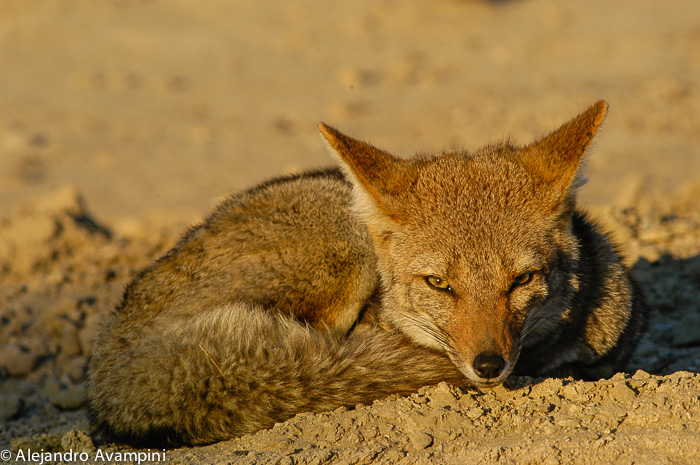 The Grey Fox (Pseudalopex griseus), for the most part, lives a solitary and primarily nocturnal lifestyle. For refuge and for raising its pups it will occupy a cave built earlier by a Hairy Armadillo (Xenarthra) or other burrowing animal or in the hollow of a tree if found. They are territorial animals and will mark their area with urine or feces. They have a wide diet and are opportunistic feeders, taking advantage of the situations that may arise they will eat mammals, birds, eggs, reptiles, insects and a good portion of fruit and vegetable matter.
The Grey Fox (Pseudalopex griseus), for the most part, lives a solitary and primarily nocturnal lifestyle. For refuge and for raising its pups it will occupy a cave built earlier by a Hairy Armadillo (Xenarthra) or other burrowing animal or in the hollow of a tree if found. They are territorial animals and will mark their area with urine or feces. They have a wide diet and are opportunistic feeders, taking advantage of the situations that may arise they will eat mammals, birds, eggs, reptiles, insects and a good portion of fruit and vegetable matter.




